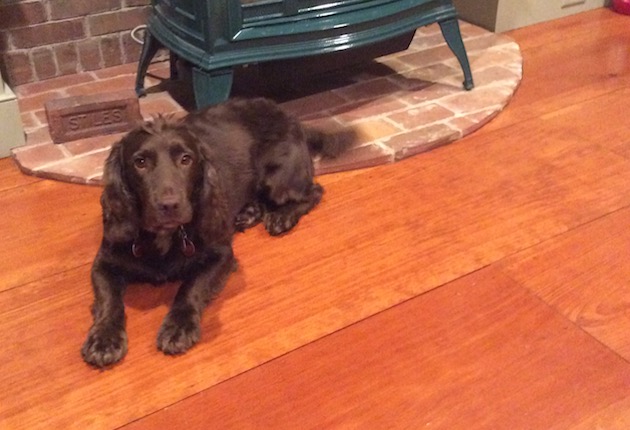My wife, Joanne, passed away ten months ago. Her ashes are in an urn on the window seat next to the space her hospital bed once occupied. When she was wheeled out of the house, her son, her daughter, and her husband toasted her: “She is on her way.”
Four days later her ashes were returned, and I placed her on the window seat. A presence that had left the house and whose absence had made it a very lonely place was back. That old cliché “a breath of fresh air” fits. Joanne’s spirit had returned. I talk to her every morning over coffee and every evening before I go to bed—of children, grandchildren, our great-granddaughter, news and gossip, the day’s doings.
About a month after Joanne passed, we were continuing our ongoing discussion about our next dog. We had taken a break from dogs while we traveled for months at a time during retirement. But we knew that when we slowed down, we’d get another. We had talked breeds and had decided on an English cocker spaniel of bird hunting lines—big enough to be useful retrieving all birds except geese and small enough not to be a “thud” around the house.
“Bob,” Joanne said, “it’s time to find our dog.”
And so the search began. Cocker spaniels, as a breed, had gone in two directions—American cocker spaniels are bred for show; English cocker spaniels are bred for hunting. The show dogs are beautiful, soft, well-trained arena dogs; the hunting dogs are 35 pounds of muscle and intensity.
I searched the web, put the word out among my shooting friends, wrote, phoned, talked. Finally, I read an article in the dog section of Sporting Classics. Two thirds of the article was about a breeder and trainer of English cocker spaniels with a phone number. I picked up my phone and placed a call to South Dakota.
Scott and Tyla Kuhn are the husband and wife team who run Sunsage Sporting Dogs, a hunting dog and guiding operation. They breed their own puppies and run a select group in their hunting operation in South Dakota (pheasant) and Georgia (quail). As the dogs become more experienced and valuable, they sell them to guides, hunting lodges, and hunters.
Scott answered the phone. After the initial pleasantries and some talk about English cockers, I said, “Before we get too far along, let me describe myself, the type of hunting I do, and what I’m looking for.” Scott said to go ahead.
“I’m seventy years old. I hunt ruffed grouse and woodcock in heavy brush and steep hills in New Hampshire and Vermont. I’m only good for two hours of brush busting on a hunt; then I go back home and take it easy for the rest of the day.”
Scott laughed, and I knew that I had a sympathetic listener.
“I don’t want a puppy or a young dog that expects to go all day. I want an older, experienced dog—preferably a female—who will go on a two-hour hunt with me and then crawl onto my lap at home while we both rest. One who will be good for the three or four seasons more that I think I can manage. Then we will stop hunting, and both of us will grow old together.”
We talked a bit more, and Scott said, “I know exactly what you want. Let me talk to my wife.”
Tyla called the next day. I told her what I wanted and that, when not hunting, the dog would live in the house with a free run of carpets, couches, and bed. I said that I hoped that she would spend a lot of time at my feet or curled up in my lap or against my side.
“Bob,” Tyla said, “I’ve been looking for someone like you to place Mocha. She is my dog and one of the breeding mothers of our line. She is six years old and has retrieved more than a thousand birds (the Kuhns guide for major commercial-hunting operations). What you describe will be a fitting retirement for her.”
Pictures, pedigrees, price, guarantees, shipping, and more talk. Mocha arrived in November. We hunted 30 days. The ruffed grouse population is down in New England, but she moved some birds and I got some shots. After the hunts we came home and sat together in front of the stove as I told Joanne all about the flushes—simply wonderful.
Hunting season is over now, and for the past months I have been throwing the training bumper for Mocha two times a day for 20 minutes. She loves the snow and plows through it like a little tank. We just came in from a bumper session a few minutes ago, and as I write this Mocha is curled up on my left foot. All three of us are content.

